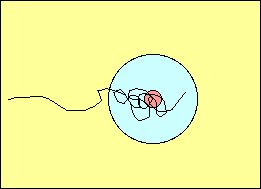Kineses
What does an animal do when it has a specific need, such as food, a higher
humidity environment, or shelter from the sun, but it has no information about
the location of the needed resource? It may engage in an undirected
search, or kinesis.
 |
This simple diagram illustrates the basics of an undirected
search. The animal, travelling from left to right in the diagram, moves
in a more or less straight line through unsuitable habitat. When it begins
to perceive better conditions (the blue area) two things can change--its
rate of speed and the angle of its turns. By turning sharper angles and
slowing down, it stays in the vicinity of the improved conditions. Simple
changes in movement pattern, in response to better environmental condidtions,
amount to habitat selection. Conversely, if an animal finds itself in
poor conditions, rapid, straightline movements will increase its likelihood
of finding better conditions. |
page 6-*
copyright ©2003 Michael D. Breed, all rights reserve
